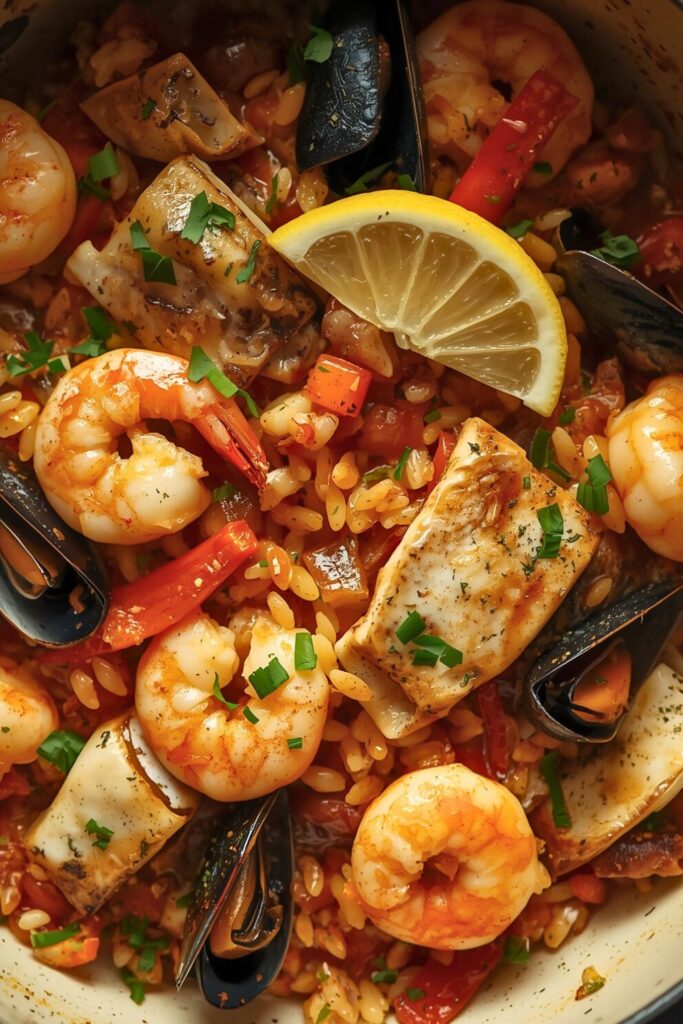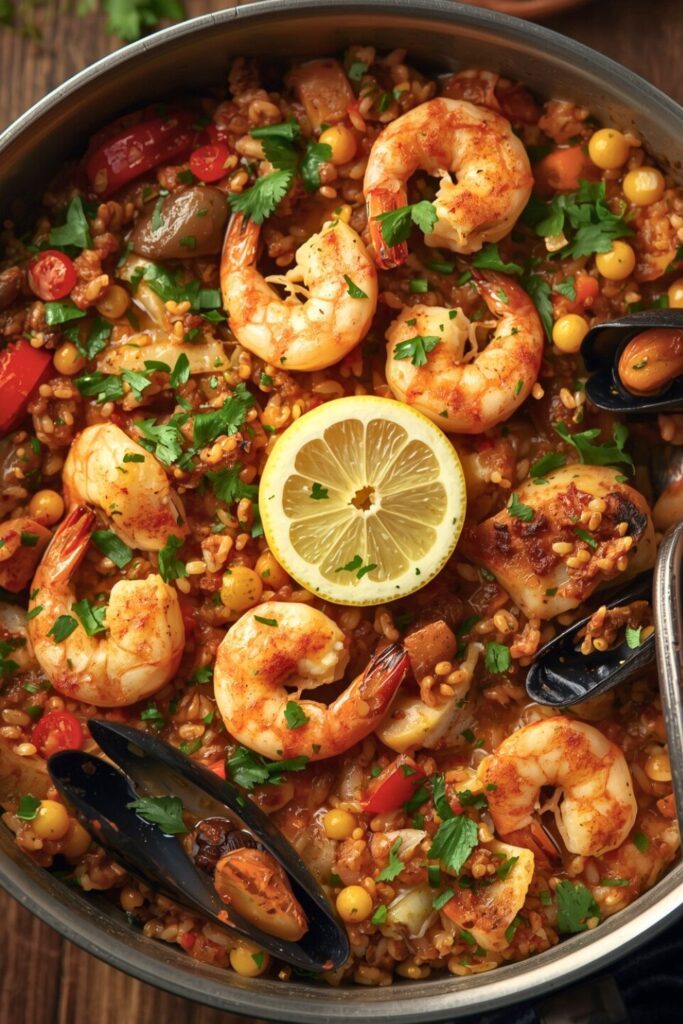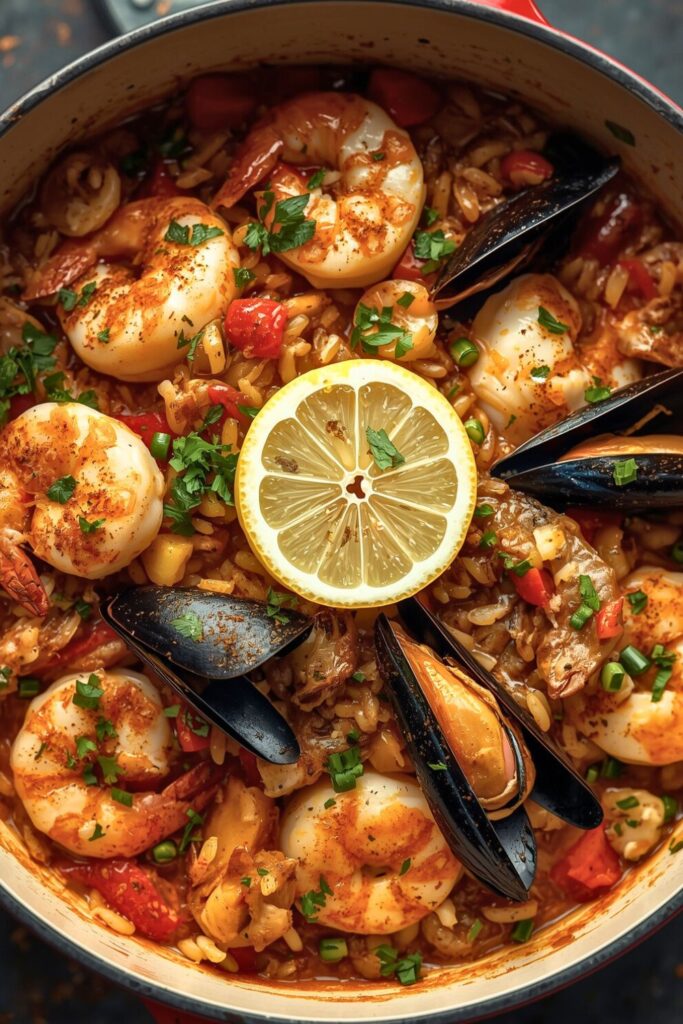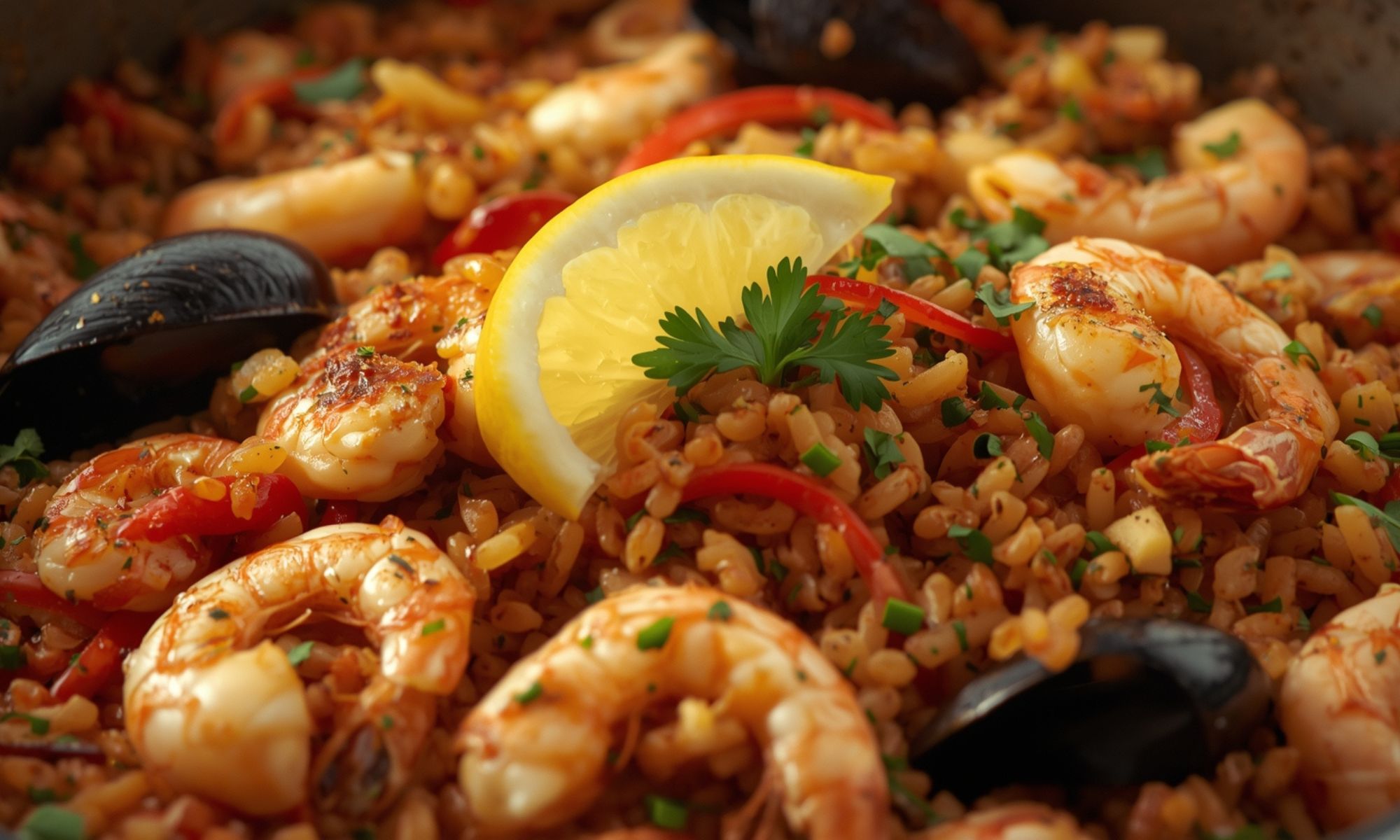You know that moment when the day runs long, the fridge looks uninspiring, and takeout feels like the easy, but boring, option? The kids are restless, your stomach’s louder than the TV, and you’re standing in the kitchen thinking, “I need dinner, fast, but it better taste like more than just survival.” That’s exactly when Quick One Pot Seafood Rice steps in.
For me, it started on a rainy Tuesday with a half empty pantry, a bag of shrimp hiding in the freezer, and rice that was practically begging to be used. Not a cookbook fix. Just me, a craving, and the quiet hum of the stove as I tossed garlic into hot butter and listened to it sizzle like a promise.
Soon, the kitchen smelled alive, seafood softening into the steam, grains of rice soaking up tomato rich broth, a little chili heat humming in the background. It wasn’t fancy, but it had everything: warmth, depth, and that golden balance of comfort and speed. A dish born out of “what do I even make?” suddenly became “why haven’t I made this sooner?”
And here’s the best part: it all happens in one pot. Fewer dishes, bigger flavor, and a recipe you’ll want to repeat every time life feels a little too loud. Keep reading and I’ll walk you through the step by step, plus a few easy swaps and serving ideas to make it your own. Trust me, once you taste this, Quick One Pot Seafood Rice will be your weeknight lifesaver.
Why This Quick One Pot Seafood Rice Will Become Your Go To

The magic happens in three stages. First, we build our flavor base with aromatics that’ll make your kitchen smell like heaven. Then we create steam pockets that cook our rice to fluffy perfection while keeping the seafood tender and juicy. Finally, we finish with a technique that creates that coveted crispy bottom layer, what the Spanish call socarrat, that adds texture and deep, toasted flavor.
What really sets this apart from other one pot meals is how we control moisture and heat. Most people dump everything together and wonder why their rice is mushy or their shrimp is rubber. We’re gonna be smarter about it.
The cultural roots run deep too. This technique draws from centuries of coastal cooking traditions where fishermen needed to create satisfying meals from their daily catch using whatever grains and vegetables they had on hand. It’s comfort food with soul.
Essential Ingredients for Perfect Seafood Rice
Let me walk you through this like we’re shopping together, because ingredient quality makes or breaks this dish.
For the Protein (choose your adventure):
- 1 pound mixed seafood, I love using half shrimp, half mussels, but scallops and firm fish work beautifully
- If using shrimp, go for 16-20 count (that’s medium large), they won’t disappear into the rice
- Fresh is ideal, but good frozen seafood that’s been properly thawed works perfectly
The Rice Foundation:
- 1½ cups bomba rice (traditional Spanish), Arborio, or short grain white rice
- Never use long grain rice here, it doesn’t absorb flavors the same way
- Jasmine rice works in a pinch, but reduce liquid slightly
Building Flavor:
- 3 cups warm seafood or chicken stock (homemade preferred, but quality store bought works)
- ¼ cup dry white wine (drink the rest while cooking)
- 2 tablespoons good olive oil
- 1 large onion, finely diced
- 4 garlic cloves, minced
- 1 red bell pepper, cut into strips
- ½ cup tomatoes, grated (Spanish technique, grate fresh tomatoes, discard skin)
The Magic Touch:
- Pinch of saffron threads (non negotiable for authentic flavor)
- 1 teaspoon smoked paprika
- ½ cup green peas (frozen is fine)
- Fresh parsley for finishing
- Lemon wedges for serving
Smart Swaps That Actually Work:
Can’t find saffron? Turmeric gives color but won’t replicate the flavor, use half the amount and add a bay leaf for complexity. Living somewhere without bomba rice? Calrose or any short-grain rice designed for risotto works. Arborio’s your best bet in most grocery stores.
For the wine free folks, use extra stock with a splash of white wine vinegar. The acid is what we’re really after, it brightens everything up. No fresh tomatoes? Use 2 tablespoons tomato paste thinned with a little stock.
Here’s something most recipes won’t tell you: the quality of your stock matters enormously. If you’re using store bought, choose low sodium versions. Better yet, save shrimp shells and make a quick stock while you prep, just simmer them with onion scraps and herbs for 20 minutes.
Mastering the One Pot Seafood Rice Technique

This is where the magic happens, and timing is everything. Don’t worry though, I’m gonna walk you through each step like I’m right there beside you.
Step 1: Create Your Flavor Base
Heat your olive oil in a wide, heavy bottomed pan or paella pan over medium heat. We want something with a large surface area, this isn’t the time for your narrow saucepan. Add your diced onion and let it soften for about 5 minutes. You’ll know it’s ready when it’s translucent and smells sweet, not sharp.
Add the garlic and red pepper. Cook for another 2 minutes until fragrant. Here’s where most people mess up,they crank the heat too high and burn the garlic. Keep it gentle. Burned garlic tastes bitter and ruins everything.
Step 2: Build Depth
Stir in your grated tomato and cook until the liquid evaporates and it darkens slightly, about 3 minutes. This concentrates the tomato flavor and creates what Spanish cooks call a “sofrito.” It’s the backbone of your dish.
Add the saffron (crush it between your fingers first to release oils) and smoked paprika. Cook for 30 seconds until incredibly aromatic. The kitchen should smell absolutely amazing at this point.
Step 3: The Rice Commitment
Pour in your rice and stir to coat every grain with the sofrito. This is crucial, we want each grain to be sealed and flavored before we add liquid. Cook for 2-3 minutes, stirring occasionally, until the rice looks slightly toasted.
Add the wine and let it bubble and reduce by half. This cooks out the alcohol and concentrates the flavor. Now comes the most important part: add your warm stock all at once. Don’t add it gradually like risotto, we want different results here.
Step 4: The Hands Off Phase
Bring everything to a boil, then immediately reduce to a gentle simmer. Here’s the crucial part: do not stir from this point forward. I know it’s tempting, but stirring now will make your rice gummy. Trust the process.
Let it simmer for about 10 minutes, then nestle your seafood into the rice. Start with anything that takes longer to cook (like mussels) and add quicker cooking items (like shrimp) a few minutes later.
Step 5: The Socarrat Magic
In the final 5 minutes, increase heat to medium high. You’ll hear gentle crackling, that’s the socarrat forming on the bottom. It should smell toasty, not burned. If it smells acrid, lower the heat immediately.
Add your peas in the last 2 minutes. They just need to warm through and brighten up.
The Science Behind Perfect Seafood Rice
Understanding what’s happening in your pan transforms you from someone who follows recipes to someone who creates great food. When we toast the rice in the sofrito, we’re creating a barrier that helps each grain maintain its structure. This is why paella rice stays al dente rather than turning mushy.
The saffron does more than add color and flavor, it contains compounds that actually help preserve the rice’s texture. That’s why traditional paella recipes are so insistent on using it. It’s not just tradition; it’s chemistry.
When we add all the liquid at once instead of gradually, we create different steam dynamics than risotto. The rice absorbs liquid at a steady rate while the surface evaporates, concentrating flavors. This is why we don’t stir, we want those steam pockets to form and work their magic.
The socarrat isn’t just for show either. Those caramelized bits on the bottom add a smoky depth that elevates the entire dish. In Valencia, the quality of a paella is often judged by its socarrat. Too little and it’s bland; too much and it’s burned. Finding that sweet spot is an art.
Your pan choice matters more than you’d think. Wide, shallow pans allow for better evaporation and more even cooking. The rice layer should be no more than two inches deep. Traditional paella pans are designed specifically for this, they maximize surface area while maintaining even heat distribution.
Presentation and Perfect Pairings

Let’s make this look as incredible as it tastes. The beautiful thing about this dish is that it’s naturally gorgeous, the saffron gives everything a golden glow, the seafood adds pops of color, and the fresh parsley brightens everything up.
Serve it directly from the pan if you’ve got a pretty one. There’s something convivial about gathering around a paella pan that makes any dinner feel like a celebration. If you’re plating individually, use a wide, shallow bowl and make sure to scrape up some of that precious socarrat for each serving.
Finish with fresh parsley and lemon wedges. The acid from the lemon is crucial, it brightens all the rich flavors and makes the seafood pop. A drizzle of good olive oil doesn’t hurt either.
Wine Pairings That Work: Spanish whites are traditional, try Albariño or Verdejo if you can find them. Sauvignon blanc or Pinot Grigio work beautifully too. The key is crisp acidity that won’t fight with the saffron. If you’re a red wine person, go light, a Spanish Tempranillo or French Côtes du Rhône won’t overpower the delicate seafood.
Side Dishes That Complete the Meal: Keep it simple. A crisp green salad with sherry vinaigrette echoes the Spanish flavors. Crusty bread for sopping up any remaining liquid. Maybe some Marcona almonds or olives if you want to go full Spanish tapas style.
Why This Recipe Deserves a Permanent Spot in Your Rotation
Here’s the thing about Quick One Pot Seafood Rice, once you master the basic technique, it becomes a template for endless creativity. It’s sophisticated enough for company but simple enough for weeknight dinners. It uses one pan, which means minimal cleanup. And it’s the kind of dish that makes people think you’re a much better cook than you actually are.
The technique scales beautifully too. Making it for two? Use a smaller pan and halve the recipe. Feeding a crowd? Double everything and use your biggest pan or roasting dish. The principles remain the same.
Most importantly, it connects you to centuries of coastal cooking tradition while being completely approachable for modern home cooks. There’s something deeply satisfying about mastering a technique that’s been perfected over generations.
Quick One Pot Seafood Rice: Q&A
Can I make this recipe ahead of time?
Honestly? This dish is best enjoyed fresh from the pan. The textures change when reheated – the rice can get mushy and the seafood tough. That said, you can prep all your ingredients ahead of time, make the sofrito base and store it in the fridge, then finish the dish when you’re ready to serve. It’ll cut your active cooking time in half.
What should I do if my rice is undercooked but the liquid is gone?
Don’t panic, this happens more often than you’d think. Add warm stock, about ¼ cup at a time, and continue cooking on low heat. Cover the pan with a clean kitchen towel, then place the lid on top. This creates gentle steam that’ll finish cooking the rice without making it mushy.
My seafood turned out rubbery. What went wrong?
Overcooking is the usual culprit here. Shrimp should be added in the final 3-4 minutes, scallops need even less time. If you’re using delicate fish, nestle it in during the last 5 minutes and don’t move it around. Remember, residual heat continues cooking even after you turn off the burner, so slightly underdone is better than overdone.
Can I use brown rice instead of white rice?
You can, but you’ll need to adjust the technique significantly. Brown rice needs more liquid and longer cooking time, probably 45 minutes total instead of 20. Add the seafood much later in the process, and you likely won’t achieve the same socarrat. It’s a different dish at that point, but still delicious in its own way.
How do I know when the socarrat is perfect?
Listen more than you look. You’ll hear gentle crackling and sizzling, that’s good. The smell should be toasty and nutty, never acrid or burned. If you gently lift one edge with a spatula, you should see golden brown (not black) bits on the bottom. It takes practice to get it just right, but even imperfect socarrat is better than no socarrat.

Swiftly Captions by Tina Smith — Quick, flavorful food recipes made simple, bringing fresh inspiration to your kitchen every day






